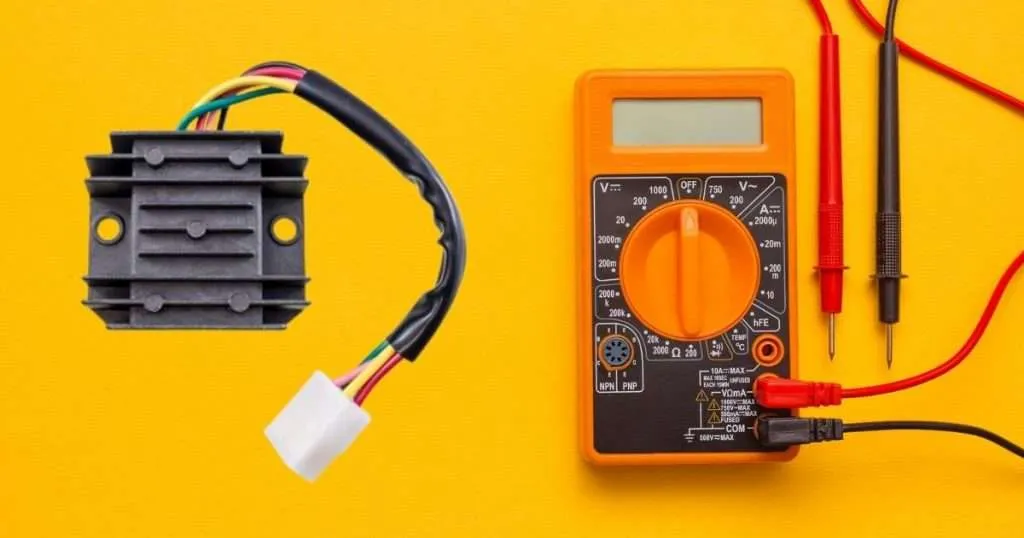A rectifier is an electrical device that converts alternating current (AC) into direct current (DC), a process known as rectification. Rectifiers are used in various applications, from power supplies to audio equipment. We can use a multimeter to test a rectifier to ensure it works correctly.
Rectifiers are used in various applications, from power supplies to audio equipment. To test a rectifier with a multimeter, you will need to set the multimeter to the DC voltage setting. If the rectifier is faulty, it will need to be replaced.
Let’s discover this in detail.
Table of Contents
ToggleHow to test a rectifier with a multimeter
If you must test a rectifier mounted in the engine, set the multimeter to the DC voltage setting. Turn on the power to the rectifier, and take a reading on the multimeter. Connect the red probe to the cathode and the black probe to the anode of the rectifier.
If the rectifier works appropriately, the multimeter will show a DC voltage reading in the recommended range. If you do not see a DC voltage reading, the rectifier is not working correctly and needs to be replaced.
However, if a rectifier is out of the engine, test continuity between its terminals as there is no DC power supply.
Let’s have a detailed look at these steps.
-
Tools Required
- A digital or analog multimeter
- A rectifier to test
-
Identify the negative and positive terminals
- You can consult the device’s datasheet if you are unsure how to identify a rectifier’s positive and negative terminals. The datasheet will usually have a diagram showing which terminal is which.
- Alternatively, a digital multimeter can also test for continuity between the two terminals. The positive terminal has a “+” sign, while the negative terminal has a “-” symbol.
-
Connect the rectifier to the multimeter.
- Once you’ve identified the terminals, you can connect the leads of your multimeter to them. Ensure you set the multimeter to measure DC voltage, not AC voltage.
- Then, take a reading and compare it to the recommended value for your rectifier.
-
Compare the measured value with the ideal range.
- If you’re unsure what the expected value should be, you can consult the datasheet for your rectifier. If the value measured using the multimeter is within the range specified in the datasheet, your rectifier is probably working correctly.
- However, if the measured value is outside of that range, then your rectifier might be defective and need to be replaced. The datasheet will usually list the maximum and minimum voltage that the rectifier can produce.
Frequently Asked Question
What issue do users face while testing a rectifier with a multimeter?
One issue that users may face when testing a rectifier with a multimeter is identifying the positive and negative terminals of the rectifier. Another problem users may face is setting the multimeter to measure DC voltage instead of AC voltage.
Yet another issue that users may face is knowing what the expected value for the rectifier should be. These issues can be resolved by consulting the rectifier’s datasheet or using a digital multimeter to test for continuity between the two terminals.
What are the common causes of faulty rectifiers?
There are a few common causes of faulty rectifiers, such as an old or expired rectifier. Another common reason is that a power surge has damaged the rectifier.
If you suspect your rectifier might be defective, it’s always best to consult a qualified electrician to diagnose the problem.
Conclusion
Testing a rectifier with a multimeter is a straightforward process. Ensure you correctly identify the positive and negative terminals and set your multimeter to measure DC voltage. With some practice, users can learn how to get accurate readings every time.
To test a rectifier with a multimeter, you’ll need first to identify the positive and negative terminals of the rectifier. Once that’s done, you can connect the multimeter’s leads to the corresponding terminals and set the meter to measure DC voltage.
Finally, compare the multimeter reading with the excellent case value.
Related Guides:





